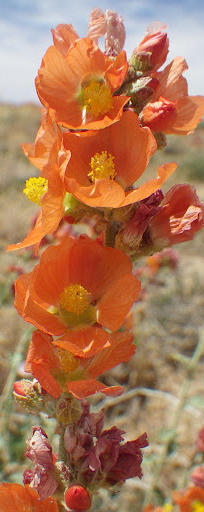Sphaeralcea parvifolia Nel.
Viridiplantae > Streptophyta > Streptophytina > Embryophyta > Tracheophyta > Euphyllophyta > Spermatophyta > Magnoliopsida > Mesangiospermae > eudicotyledons > Gunneridae > Pentapetalae > rosids > malvids > Malvales > Malvaceae > Malvoideae > Sphaeralcea > parvifolia [1]

Flower. Photo by Matt Lavin [2]
Stems few to many from branching woody caudex. Leaves with blades 1.5-5.5 cm long, 1.2-5.2 cm wide, ovate to orbicular, reniform, or cordate-ovate, the base cordate to truncate or obtuse, usually shallowly 3-5 lobed, the sinuses usually shallow, the lobes wavy-toothed (crenate-dentate); inflorescence commonly narrowly thyrsoid, typically with more than 1 flower per node; pedicels (flower stalk) usually shorter than the calyx. Calyx uniformly stellate-hairy (with star-shaped hairs), the rays of hairs not in a single plane, calyx lobes lance-ovate to deltoid; petals 7-15 mm long, orange; carpels 10-12, 3-4 mm high, the indehiscent part forming from ¼-1/3 of the carpel, faintly reticulate on the sides [3].
![Entire Plant. Photo by Patrick Alexander [4]](/crfs/images/native-plants/plant-directory/mohaveglobemallow-sec.jpg)
Entire Plant. Photo by Patrick Alexander [4]
Sphaeralcea parvifolia can be difficult to identify and distinguish from other species like S. ambigua and S. incana. It is important to note the elevation of the specimen [3]. Small-leaf Globemallow is typically found at 4,000-7,000 ft (1219-2134 m) [5]. If the question is between S. parvifolia and S. ambigua, S. parvifolia flowers are typically more numerous and smaller than those of S. ambigua. Also, the carpels of S. ambigua are more reticulate (net-veined) and more hood or helmet shaped than those of S. parvifolia. This species is also commonly misidentified as S. incana, but can be distinguished by the color of the herbage. S. incana has a yellowish hue, while S. parvifolia herbage is whitish or grayish, and has smaller and rounder leaves than S. incana [5].
This plant has also been known as Sphaeralcea ambigua subsp. rugosa, Sphaeralcea ambigua var. rugosa, Sphaeralcea arizonica, Sphaeralcea marginata. The similarities between S. ambigua and S. parvifolia have led researchers to believe that they were the same species, but they have since split them and are now considered their own species with slight differences in their morphology [5].
![Flower and Leaf. Photo by Joe Fife [6]](/crfs/images/native-plants/plant-directory/mohaveglobemallow-third.jpg)
Flower and Leaf. Photo by Joe Fife [6]
Indigenous peoples have used this plant for many different ailments and afflictions. The Hopi used it to aid in difficult defecation in both adults and infants [7]. Modernly, this plant is used in restorative projects, erosion control [3] and as an ornamental in native gardens. Studies back in the 1960’s showed the plant useful food for wildlife and livestock alike, discovering a broad animal base that ate this plant or used for dens and nests. Many studies have been done on water usage, flowering times, and overall ecological roles as it seems to be an important species for native ecosystems [8].
![Distribution map of Sphaeralcea parvifolia at a county level [9].](/crfs/images/native-plants/plant-directory/mohaveglobemallow-fourth.jpg)
Distribution map of Sphaeralcea parvifolia at a county level [9].
The Sphaeralcea parvifolia has been categorized as, “Least Concern” [10].
Habitats include blackbrush, other warm desert shrubs, sagebrush, pinyon-juniper, and mountain brush communities at 820-2700 m [3].
[1] Schoch CL, et al. NCBI Taxonomy: a comprehensive update on curation, resources and tools. Database (Oxford). 2020: baaa062. PubMed: 32761142 PMC: PMC7408187.
[2] Photo by Matt Lavin. https://www.flickr.com/photos/plant_diversity/9966376384/in/photolist-2oCupwe-KYXRNy-9NDqUB-KSsGDm-gbG9P8-gbG46K-KAy2UE-2e6moft-u5veJn-gbGfg9-qfkoBQ-2fpzrB3-nvg1vV-gbGre3-gbGhtA-gbGg65-2meevpb-2meh9TS-nvfzF7-t8tYh1-nPwvWr-eLBZBp-2oNsq53-fPS5V8-nMG8td-UV4E8g-o2zzBn-HkiLa8-oMsYCZ-rbGGpb-nNfsgB-XPwBFE-neXkhp-nNGvAa-9VgRoH-ndkUk5-nMEx8w-sv7SdG-eNGaak-JgERy8-HsgvQR-eNG8kk-eNTx5m-s8yBjW-6SfLZg-4Xe5Fw-2gbwSEm-eKQh7n-ndkBgz-ESu1Mn/
[3] Welsh, S. L., Atwood, N. D., Goodrich, S., & Higgins, L. C. (2016). A Utah flora (Third). Monte L. Bean Life Science Museum.
[4] Photo by Patrick Alexander. https://commons.wikimedia.org/wiki/File:Sphaeralcea_parvifolia_-_Flickr_-_aspidoscelis.jpghttps://commons.wikimedia.org/wiki/File:Sphaeralcea_parvifolia_-_Flickr_-_aspidoscelis.jpg
[5] Sphaeralcea parvifolia. SEINet Portal Network -. (n.d.). Retrieved May 7, 2024, from https://swbiodiversity.org/seinet/taxa/index.php?taxon=sphaeralcea%2Bparvifolia&formsubmit=Search%2BTerms
[6] Photo by Joe Fife
[7] Colton, Harold S., 1974, Hopi History And Ethnobotany, IN D. A. Horr (ed.) Hopi Indians. Garland: New York., page 363
[8] Gucker, C. L., & Shaw, N. L. (2018). Small-Leaf Globemallow. Home. Retrieved September 29, 2022, from https://www.blm.gov/sites/blm.gov/files/uploads/SPPA2.pdf
[9] USDA, NRCS. 2022. The PLANTS Database (http://plants.usda.gov, 09/28/2022). National Plant Data Team, Greensboro, NC USA.
[10] USDA. (n.d.). Small-leaf globemallow (sphaeralcea parvifolia A. Nelson) plant guide https://plants.usda.gov/DocumentLibrary/plantguide/pdf/pg_sppa2.pdf



